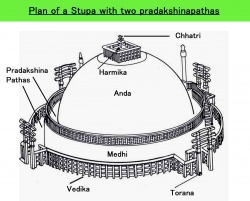Chaitya-griha
Chaitya-griha; Chaitya; the name for various sacred objects in India.
In art history, the term is usually used in reference to an architectural type characteristic of Buddhist architecture in ancient and medieval India.
It consists of an elongated cave cut into a cliff, with a vaulted ceiling and a stupa in the back as an object of worship. These monastic buildings built of bricks were self-contained units and had a Chaitya hall or Chaitya mandir attached to a stupa - the chief object of worship.
Chaitya grihas or halls of worship were built all over the country either of brick or excavated from rocks.
Ruins of a large number of structural Buddhist chaity grihas are found in the eastern districts of Andhra Pradesh, in valleys, near rivers and lakes.
The ruins located in the districts of Srikakulam at Salihundam, of Visahkapatnam at Kotturu, of West Godavari at Guntapalli, of Krishna at Vijayawada, of Guntur at Nagajunakonda and Amaravati belong to the 3rd century BC and later.
The largest brick chaitya hall was excavated at Guntapalli. The chaitya at Bhaja is a long hall 16.75 metres long and 8 metres broad with an apse at the end. The hall is divided into a central nave and an aisle on either side flanked by two rows of pillars. The roof is vaulted. The rock-cut stupa in the apse is crowned by a wooden harmika. The chaitya has a large arched torana or entrance with an arched portico.
